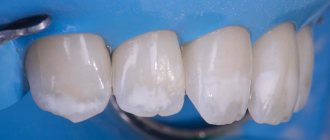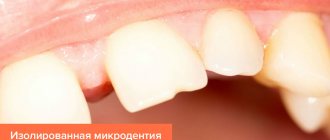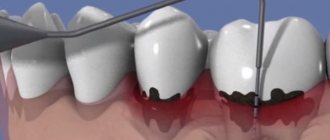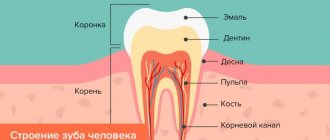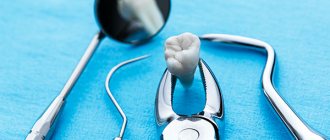What causes dental caries?
Caries is a progressive disease that destroys the hard tissues of the tooth. Cariogenic bacteria live in the oral cavity; they form a biological film on the surface of the teeth - dental plaque. They feed on carbohydrates that enter our bodies through food and drinks. Bacteria process sugars and produce organic acids. Those, in turn, corrode tooth enamel and deep tooth tissues. This is how caries develops.
In this article
- What causes dental caries?
- How does caries progress?
- A dangerous complication of caries is pulpitis.
- How is pulpitis treated?
- Periodontitis as a dangerous consequence of caries
- How is periodontitis treated?
- What is the danger of caries for the gastrointestinal tract?
- ENT diseases as consequences of caries
- Why is caries dangerous for the heart and blood vessels?
- Risk of death from dental caries
- Conclusion
Although bacteria living in the oral cavity play an important role in the development of carious lesions, a complex of unfavorable factors is important for tooth decay:
- an abundance of “fast” carbohydrates in the diet (sweets, flour);
- poor dental and oral hygiene;
- lack of calcium, fluorine, phosphorus, vitamin D in the body;
- weakened immunity.
Signs of caries in children
After solving the question “does caries of baby teeth need to be treated,” a new one appears. Namely: how to understand that a child has caries?
The symptoms of dental diseases are simple:
- Complaints of pain - at night, during meals or during the day.
- The appearance of yellow or brown spots on the enamel of the teeth.
- Bad breath.
- Excessively careful chewing of food - with teeth on only one side.
Unfortunately, caries can occur without visible signs. For this reason, dentists advise periodically examining the child’s oral cavity and monitoring the quality of teeth cleaning.
How does caries progress?
There is a myth that caries is necessarily a hole in the tooth, but in reality, dental disease begins with the loss of mineral substances in the tooth enamel and gradually progresses. Caries goes through four stages in its development. Let's look at them below.
- Spot stage.
There is no hole in the tooth yet, but a whitish spot is noticeable on the surface. A change in the color and structure of the enamel means that it is losing minerals in this area. At an early stage there is no pain or discomfort, so patients rarely go to the dentist, not even suspecting the presence of caries. But it is at the spot stage that caries is easiest to cure. The progression of the disease can be stopped using conservative methods without drilling or installing a filling. At this stage, remineralization, simple and deep fluoridation, and the infiltration method are effective.
- Superficial caries.
At this stage of development of the disease, a small carious cavity forms within the enamel. The patient may have the first complaints: the tooth reacts to cold and hot, sour and sweet, food gets stuck in the resulting hole.
- Average caries.
The carious cavity becomes larger and affects the dentin - the bone tissue of the tooth under the enamel. At this stage, acute toothache most often appears; food stuck in the hole causes severe discomfort, and the patient complains to the dentist. It will not be possible to cure average caries without preparing the tooth, so an operative approach is used in treatment - using a drill, the affected tissue is removed and the cavity is filled with special composite materials.
- Deep caries.
The carious lesion affects the deepest layers of dentin and approaches the dental nerve. All the symptoms that were there before intensify, sometimes becoming chronic. Frequent complications of deep caries are pulpitis and periodontitis (inflammation of the pulp and tissues surrounding the tooth root).
It is better to treat caries in the early stages, while there is no carious cavity in the tooth. Conservative methods will help stop the pathological process without drilling and filling. If a hole has already formed in the tooth, then you cannot do without a drill. What if you don't treat it? Many people have been afraid of dentists since childhood and put off visiting the doctor as much as possible. This should not be done under any circumstances, because caries is dangerous for the body due to its consequences. With an advanced form of the disease, you can lose a tooth or develop purulent inflammation. There are even cases of death from complications of deep caries. Therefore, it is imperative to treat the disease!
Tooth decay
— When should you go to the dentist?
— You should go for a consultation with a dentist when nothing hurts yet—once every six months. The doctor will tell you how to behave correctly to prevent oral diseases. Perhaps no treatment will be needed, the person will simply be informed about what problems and prospects there are.
If your tooth still hurts, you should consult a doctor immediately. Otherwise, the consequences can be severe. Of course, not everyone goes to the dentist when nothing hurts yet. But even when it already hurts, some are in no hurry.
For example, the patient had caries. It destroyed the tooth tissue and reached the nerve. A person does not sleep at night from pain. In the end, the nerve also dies from infection and begins to disintegrate. The jaw around the tooth also becomes infected and inflamed, then it comes to the bone tissue of the jaw. And then we are talking not only about preserving the tooth, but also about preserving human life.
Dental clinic No. 3.
Altapress.ru.
A dangerous complication of caries is pulpitis.
The most common consequence of untreated caries is pulpitis. It occurs when the infection extends beyond the tooth and spreads to the pulp - the neurovascular bundle, or dental nerve.
The pulp contains nerves and blood vessels and provides nutrition to the dental tissues. Therefore, with pulpitis, the tooth may lose vitality. In severe cases, inflammation spreads to neighboring tissues.
A characteristic symptom of pulpitis is acute, prolonged pain that is difficult to tolerate. It often has a pulsating nature and can radiate to the temple, ear, or throat. The peculiarity is that attacks of pain appear at certain intervals, last about 5 minutes, and can intensify when lying down. It is necessary to begin treatment of pulpitis as quickly as possible.
How is pulpitis treated?
Pulpitis can be treated biologically or surgically. The first is applicable if the disease is in its early stages. The dentist strives to preserve the pulp by eliminating only the inflammation. If possible, pulpitis of primary teeth is treated using a biological method, when it is especially important to preserve the tooth root. Treatment is carried out in several stages. First, the dentist prepares the carious cavity, opening it as wide as possible. Then he treats it with an antiseptic, puts a swab with an antibacterial agent and covers the tooth with a bandage. During the next appointment, if the patient has no complaints, the cavity is treated with medication, filled with a special composition that stimulates dentin production, and a temporary filling is placed for a period of 5 to 7 days. During the third appointment, the dental crown is filled.
When the biological method of treating pulpitis is ineffective, surgical treatment is used. In this case, the inflamed neurovascular bundle is removed completely or partially. Without a nerve, a tooth becomes unviable and its service life is reduced.
Surgical treatment is performed with local anesthesia. First, the carious cavity is prepared, the pulp is removed, the affected area is treated with an antiseptic, medication is injected, and first the root canals are filled, and then the dental crown. As with the biological method, surgical treatment is carried out over several visits to the dentist.
If pulpitis is not treated, it will progress and can lead to very serious complications:
- flux - inflammatory process in the periosteum;
- periodontitis - inflammation of the tissues surrounding the tooth;
- pulp necrosis - death of its cells;
- sepsis is a blood infection that can develop when an infection enters the bloodstream.
You can avoid such complications if you do not delay your visit to the dentist and begin treatment for the disease at the first symptoms.
No tooth - no problem
“Often older people think: I only have three teeth left, okay, I won’t even brush them.” Is it necessary to undergo treatment in this case?
— The oral cavity is not sterile, it has a special microflora, so it is always necessary to take care of it. Even if there are no teeth, because the mucous membrane can also be injured and lead to more serious diseases.
Radmila Labyntseva.
Altapress.ru.
— It is believed that braces are a matter for children. Why does malocclusion occur in adulthood and how important is it to correct it?
— There are many reasons for malocclusion in adults. Most often these are consequences of dental development disorders in childhood. Mostly, malocclusion is diagnosed in people whose childhood was spent, again, in Soviet times.
At that time, the aesthetic component of treatment was relegated to the background; people were more concerned about health. Basically it was like this: the tooth got sick - it was removed. No tooth - no problem. If the parents had taken the child to the doctor in time, the malocclusion could have been corrected, the teeth could have been saved, and with them the health of the entire oral cavity.
In addition to external distortions, malocclusion can affect the quality of food digestion and even speech. This is also psychologically important, because a person with such a pathology is embarrassed not only to communicate, but also to open his mouth.
Dentist. Dental treatment.
CC0
Periodontitis as a dangerous consequence of caries
Against the background of untreated caries and dental pulpitis, the infection penetrates even deeper. As a result, periodontitis develops. This is a disease in which the tissue around the tooth root becomes inflamed - periodontium. Essentially, it is a ligamentous apparatus that holds the tooth in the jaw and provides shock absorption. With periodontitis, an abscess may form near the diseased tooth, and in this case, treatment will require opening the tooth and cutting the gum.
Periodontitis can occur in acute and chronic forms. Acute is characterized by a rapidly developing inflammatory process. The tooth darkens, becomes loose, the patient complains of acute pain, inflammation of the cheek may occur, and swelling appears in the area of the affected tissue. In a chronic course, pronounced symptoms may be absent, and pain occurs only during periods of exacerbation. Chronic periodontitis requires long-term complex therapy, which can take several months. The disease greatly weakens the immune defense and generally negatively affects the condition of the body.
How is periodontitis treated?
The approach to treating periodontitis may vary depending on its type, severity, patient history and other factors.
The chronic form of the disease is treated according to the following scheme:
- The area of the diseased tooth is numbed with anesthetics.
- First, the affected tissue and old fillings are removed from the root canal, the tooth is depulped, and, if necessary, the root canal is expanded using dental drills or a microscopic incision.
- At the second stage, the root canal is cleaned and washed with antiseptic solutions. An antibacterial drug is placed into the canal cavity, which relieves the inflammatory process and fights infection.
- The tooth is covered with a temporary filling, and antibacterial and anti-inflammatory drugs are prescribed.
- The patient is sent home, where he must strictly follow all the dentist’s recommendations. The next appointment is usually scheduled after three or four days.
- At the second stage of treatment, a control photograph is taken. If the inflammation is stopped, the dentist removes the temporary filling and medicine from the root canals, rinses the cavities with an antiseptic, and fills the canals with a special composite material. It contains substances that help restore dental tissues and destroy pathogenic microorganisms. This filling of the canals is temporary and is needed in order to completely stop the inflammation and reduce the risk of re-developing periodontitis in the future. It is done for several months, and the tooth is again covered with a temporary filling.
- A few months later, the patient comes for a follow-up appointment with the dentist, where a tooth photograph is taken again to evaluate the effectiveness of the treatment. If the inflammation has completely stopped, the final stage of treatment begins - replacing temporary fillings with permanent ones and restoring the dental crown with a permanent light-curing filling. After this, the process of treating chronic periodontitis is considered complete.
- Unfortunately, it is not always possible to carry out conservative treatment of this disease. In advanced forms, the dentist is forced to resort to surgical treatment, when part of the root or the entire tooth is removed.
Treatment of periodontitis is long, complex and expensive, and the disease itself is a source of chronic infection, negatively affects the entire body, and weakens the immune system. It is easier and safer to contact the dentist on time and treat early caries. The consequences of an advanced disease are dangerous for the body.
A dental problem is not just a dental problem
Pain in the quads above and below can be a sign of weak ligaments (shoulder, elbow, wrist, ankle and knee joints), chronic inflammation of the joints (for example, polyarthritis), diseases of the large intestine - diverticulosis, polyposis.
Sixes and sevens (molars) are beacons of gastrointestinal diseases (gastritis, gastric or duodenal ulcers), advanced anemia, chronic pancreatitis. Problems with the top six are a reason to get checked for tonsillitis and sinusitis, diseases of the pharynx and larynx, tumor formations in the thyroid gland, mastopathy, and inflammation of the appendages. If something is wrong with the lower sixes, there are problems with the arteries, atherosclerosis. But the lower sevens are problems with the lungs (chronic pneumonia, bronchitis, bronchial asthma), polyps in the large intestine, something is wrong with the veins (varicose veins, hemorrhoids).
Have your wisdom teeth been bothering you for a long time? Make an appointment not only with the dentist, but also with the cardiologist. Coronary heart disease, congenital heart disease and other cardiac diseases - in terms of wisdom teeth. Plaque and tartar can be a signal of endocrine system disorders, a sign of gastric ulcer.
What is the danger of caries for the gastrointestinal tract?
Caries and its complications have a harmful effect not only on teeth, but also on other organs and systems of the body. In particular, diseases of the gastrointestinal tract - pancreatitis, gastritis, duodenal and stomach ulcers - often occur against the background of dental caries.
The fact is that with caries and any other dental diseases, pathogenic microflora is activated in the oral cavity. Together with food and saliva, it can easily penetrate the esophagus into the stomach and intestines, causing an inflammatory process. As microbes multiply, they crowd out beneficial microorganisms and lead to the development of gastrointestinal diseases. On the other hand, the state of the digestive organs directly depends on the quality of chewing food. Caries negatively affects this function, because with damaged chewing teeth a person cannot efficiently process food to such a state that the gastrointestinal tract can easily absorb and digest it. As a result, there is an excess load on the stomach, intestines, and duodenum, which leads to pathologies of the digestive organs. In addition, poorly chewed food makes it worse for nutrients to be absorbed.
Modern research shows that even deposits on healthy teeth can threaten the health of the stomach and intestines. Thus, the bacteria Helicobacter pylori accumulate in tartar, which contributes to the development of peptic ulcers. Therefore, not only timely treatment of caries, but also its prevention, in particular proper and regular oral hygiene, helps reduce the risk of gastrointestinal diseases.
TMJ dysfunction
Caries and subsequent pulpitis lead to tooth loss, occlusal disorders, problems with chewing, etc. This changes the load on the temporomandibular joint, causing dysfunction. When the TMJ “does not work” correctly, headaches, neck pain, bruxism, ringing and noise in the ears, and disturbances in the movements of the lower jaw may appear. If the dysfunction persists for a long time and worsens, eating disorders may develop against its background (the patient is afraid to eat solid, chewing foods because of pain), sleep disorders, depression, and other disorders.
You have questions?
We will call you back within 30 seconds
+7
Why is caries dangerous for the heart and blood vessels?
When brushing your teeth, there is a risk of injury to your gums. This can happen due to a brush that is too hard, careless use of dental floss, or sensitivity of the gums themselves. One way or another, cariogenic bacteria enter the resulting wounds, which can be carried throughout the body by the bloodstream. If they get into the tissue of the heart, inflammation of its valves may develop - infective endocarditis.
Studies show that with advanced caries, the risk of developing cardiovascular pathologies increases by 70%. When bacteria enter the blood, they settle on the vascular walls next to atherosclerotic plaques. As a result, the plaque begins to actively grow and can clog the vessel, disrupting normal blood flow. The most dangerous consequences can be thrombosis, stroke, heart attack, atherosclerosis.
How brushing your teeth makes life easier
Hygiene is another category of dental services around which panic can still be heard: “brushing your teeth spoils the enamel,” “you can damage your gums,” “it’s harmful.”
In fact, the greatest harm comes from plaque and mineralized deposits, which cause pigmentation and penetration of microorganisms deep into the enamel. As a result, teeth deteriorate, turn yellow and decay. To avoid this outcome, you need to remove plaque using professional equipment.
Typically, professional hygiene is carried out in three stages:
— removal of dental plaque with ultrasound;
— cleaning with Air Flow, which removes soft pigmented deposits;
- polishing with abrasive pastes, making the enamel surface smooth to “repel” plaque. Thus, the cleaning result lasts for a longer period.
It is recommended to carry out the procedure twice a year, after consulting with your dentist.
Risk of death from dental caries
Many people underestimate the danger of caries, considering this disease to be frivolous. However, there are known cases of death from complications of untreated caries. How is this possible?
For example, if the inflammatory process from the roots of the teeth of the upper jaw spreads to the maxillary sinuses, sinusitis may occur, which can spread greatly without treatment. When the infection extends beyond the jaws, there is a possibility of a brain abscess, purulent inflammation, sepsis - all these complications can be fatal.
Another danger is the so-called pathological fracture of the jaw. This condition is associated with a cyst in the jaw, which occurs as a complication of advanced caries.
All of these dangers are real and can occur against the background of dental caries. But it is important to understand: only an advanced carious process that has not been treated for many months or even years leads to such serious complications. With regular visits to the dentist, timely treatment of caries at the first symptoms, as well as compliance with the rules of dental hygiene and other preventive measures, the risk of serious consequences for the body is almost zero.
Each organ has its own tooth
It has been known since ancient times that the condition of a particular tooth can determine the disease in the corresponding group of organs. Today this is a scientifically proven fact. For example, by using the incisors above and below (teeth 1 and 2), diseases of the ears, bladder and kidneys can be diagnosed, and by the canines (3) the condition of the liver and gallbladder can be determined. Small molars (premolars 4 and 5) transmit data about the lungs and large intestine, and large molars (molars 6 and 7) about the stomach, spleen and pancreas, and the so-called “wisdom teeth” can tell about the condition of the heart and small intestine .
At the same time, affected teeth identified by a dentist during an examination do not always mean the presence of diseases in the corresponding internal organs. It happens that a patient presents with pain in apparently healthy teeth or even with phantom pain (a painful signal comes from an internal organ to the site of the extracted corresponding tooth). Knowing about these relationships, it is easier to identify the affected organs.
